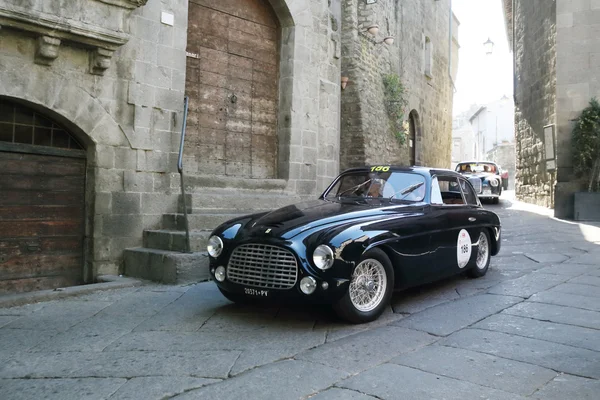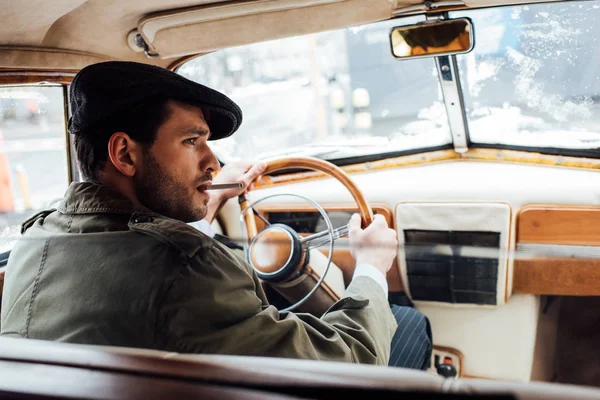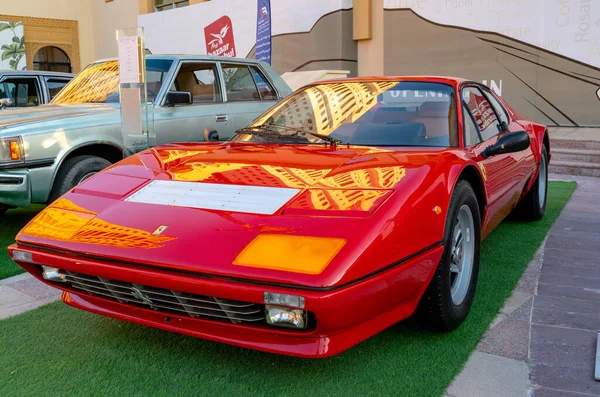The 1950s marked a golden era for this Italian luxury automotive brand called Ferrari, a time when innovation, speed, and style converged to create automotive masterpieces that are still revered today.
It’s fascinating that 1950s Ferraris played a key role in shaping the car industry.
Throughout this Ferrari-inspired piece, I’ll talk about how the Circuit de la Sarthe witnessed the peak performance of Ferrari’s consecutive Formula victories during the hours of Le Mans, solidifying the brand’s reputation for excellence. I’ll also mention some of the best Ferrari models, how collectors feel about them today, and where to spot one.
Now, without any further ado, let’s hit the gas and embark on a journey through time to uncover the captivating tale of 1950s Ferraris – where speed met style, and legends were born!
Key Takeaways
- The 1950s marked a golden era for Ferrari, with Enzo Ferrari’s vision shaping legendary cars, dominating Formula racing, and establishing the Ferrari Club of America.
- The Ferrari 212 Inter and 340 America, introduced in the early 1950s, showcased innovation and performance, setting the stage for the brand’s future success in luxury sports cars.
- Scuderia Ferrari’s racing dominance with models like the Ferrari 375 Plus at Le Mans, coupled with legendary drivers like Phil Hill and Peter Collins, solidified Ferrari’s position in motorsports.
- 1950s Ferraris owned by stars like James Dean and Zsa Zsa Gabor became symbols of opulence. Despite the challenges of time and racing, surviving examples command high prices in auctions, driven by collectors’ enduring fascination.
Overview of 1950s Ferrari
As we can all agree, the 1950s marked an extraordinary chapter in the history of Ferrari cars – no question about it. This golden era reveals not just cars, as many would perceive, but legendary masterpieces that have left an indelible mark on automotive history.
As mentioned, Ferrari is a name synonymous with luxury, speed, and precision, and it found its stride under the visionary leadership of Enzo Ferrari. His unwavering commitment to excellence laid the foundation for the celebrated early race cars and road cars that define the era.
The decade saw the birth of Ferrari’s consecutive Formula victories, with the roar of engines echoing through the iconic Circuit de la Sarthe during the exhilarating 24 hours of Le Mans. These victories showcased Ferrari’s peak performance and solidified its position as a dominant force in motorsports (also famous today).
The 1950s also witnessed the rise of the Ferrari Club of America, a testament to the growing passion and admiration for these magnificent vehicles.
Enthusiasts worldwide found themselves drawn to the sleek lines and unparalleled performance of Ferrari’s road cars, making them highly coveted even in the face of emerging modern vehicles.
The First Ferrari Road Cars

First – Ferrari 212 Inter!
The Ferrari 212 Inter, unveiled in the early 1950s, represents a paradigm shift for the legendary Italian automaker. This elegant and luxurious grand tourer, bearing the chassis number Emilia Est No., captured the hearts of automotive enthusiasts with its V12 engine and sleek design.
Its distinctively crafted bodywork, collaborating with renowned coachbuilders like Ghia and Vignale, showcased Ferrari’s commitment to excellence.
Also, it’s crucial to note its 2.6-liter Colombo-designed engine – a masterpiece revered for its performance on both road and track. With a top speed of around 120 mph, this Ferrari model set the stage for the brand’s dominance in the GT California category, earning the title of the best competition Ferrari of its time.
The second one – 340 America!
The 340 America, another gem from Ferrari’s early 1950s lineup, appeared to be the brand’s commitment to crafting extraordinary automobiles. Powered by a robust 4.1-liter Lampredi V12 engine, the 340 America boasted impressive performance figures, solidifying Ferrari’s reputation as a force to be reckoned with in the luxury sports car market.
These first cars from Ferrari, including the 212 Inter and 340 America, were not merely vehicles but manifestations of Enzo Ferrari’s vision for excellence on the road. The meticulous attention to detail and innovative engineering that defined these models laid the groundwork for Ferrari’s subsequent success.
Ferrari’s foray into road cars during the 1950s was a calculated move that resonated with automotive enthusiasts worldwide. The Ferrari Club of America, founded during this era, attests to the growing passion for these magnificent machines.
Famous 1950s Ferrari Race Cars
As mentioned, in the heart of the 1950s, Scuderia Ferrari emerged as a dominant force on race tracks worldwide, etching its legacy with iconic models that define the golden era of motorsports.
At the forefront of Scuderia Ferrari’s racing dominance was the Ferrari 375 Plus. This tough race car, bearing the chassis number Emilia Est No. , achieved a milestone victory at the legendary 24 hours of Le Mans circuit.
The 375 Plus, powered by a robust V12 engine, showcased Ferrari’s commitment to peak performance and marked a turning point in the history of endurance racing. Oh, and that bright blue roadster, an epitome of aerodynamic brilliance, soared to greatness, leaving an indelible mark on the motorsports landscape.
Le Mans, known for its grueling 24-hour races, witnessed the sheer power of the Ferrari 375 Plus during the hours of Le Mans.
The triumphant victory at this iconic circuit solidified Ferrari’s consecutive Formula dominance and catapulted the brand to unparalleled heights in the racing world. The allure of the 375 Plus lies not just in its speed but in its ability to endure the rigorous challenges of endurance racing, making it a symbol of Scuderia Ferrari’s prowess.
Turning our attention to other notable models, the Ferrari 500 Mondial and 750 Monza further exemplified Ferrari’s commitment to excellence on the track.
These race cars, finely tuned and meticulously engineered, showcased Ferrari’s consecutive Formula victories in various competitions. The 500 Mondial, a four-cylinder marvel, earned its place among the best Ferrari competitions of the time, contributing to Scuderia Ferrari’s unrivaled success in the racing circuit.
On the other hand, the 750 Monza, with its sleek design and powerful engine, became a cornerstone of Ferrari’s in-house Classiche department. Renowned for being one of the best restored Ferraris, the 750 Monza exemplified the brand’s dedication to preserving its racing heritage.
These models, with their distinct characteristics and unmatched performance, solidified Scuderia Ferrari’s position as a powerhouse in the car industry.
Legendary Ferrari Drivers of the Era

The 1950s also stand out when legendary drivers left an indelible mark on the racing world.
Phil Hill, Peter Collins, and Olivier Gendebien, the most famous names in motorsports, were instrumental in shaping Ferrari’s success during this iconic period.
So, Phil Hill, an American racing luminary, graced the tracks with the prowess that earned him a distinguished place in Ferrari’s racing legacy. Joining Scuderia Ferrari in the 1950s, Phil became the first American to win the Formula 1 World Championship in 1961.
Also, his achievements reached their pinnacle at the legendary Circuit de la Sarthe, securing victory in the 24 Hours of Le Mans in 1958. Phil Hill’s exceptional driving skills and strategic insight contributed significantly to Ferrari’s consecutive Formula triumphs.
The charismatic British driver Peter Collins played a crucial role in Ferrari’s dominance during the 1950s – learn more about 1950s cars here. Known for his elegant personality and unwavering commitment to the team, Collins partnered with Hill to secure the Formula 1 Constructors’ Championship in 1958.
His racing finesse and key role in Ferrari’s sports car victories, including the Mille Miglia, solidified his status as one of the most renowned figures in Scuderia Ferrari’s history.
Last but not least important – Olivier Gendebien!
Olivier Gendebien, a Belgian racing maestro, left an indelible mark on Ferrari’s legacy during the ’50s. His prowess in endurance racing was exemplified by four consecutive victories at the 24 Hours of Le Mans from 1958 to 1962.
Gendebien’s partnership with Ferrari resulted in world championships, showcasing the brand’s dominance in sports car racing. Also, his achievements on the world stage contributed significantly to Ferrari’s great success during this golden era.
Ferrari’s Celebrity Appeal Takes Off
As mentioned, this era saw legendary Ferrari drivers dominating the circuits and adorning the streets in their prancing horses.
James Dean, the rebel without a cause, left an indelible mark on the silver screen and the world of classic cars. His passion for speed transcended the screen and one of the most famed 1950s Ferraris linked to him recently made headlines.
The 1954 Ferrari 500 Mondial Series I Spider, chassis no. 0438MD not only represents a pinnacle of automotive design but also holds a special place in Dean’s heart.
Another treasure from the celebrity Ferrari collection takes us into the glamorous world of Zsa Zsa Gabor and Porfirio Rubirosa. Zsa Zsa, known for her timeless elegance, owned a Ferrari that mirrored her sophistication, making a statement on the streets of Hollywood.
Meanwhile, Porfirio Rubirosa, the Dominican Republic diplomat and renowned playboy, added a touch of flair with his own Ferrari Spyder.
These Ferraris, donned by stars and playboys alike, became symbols of opulence and prestige during the golden era.
Also, the Ferrari 250 GT, a classic model that graced the streets under the ownership of these stars, became one of automotive excellence.
So, from the sleek lines of Zsa Zsa Gabor‘s Ferrari to the roaring engine of James Dean’s beloved 500 Mondial Series I Spider, each celebrity-owned Ferrari tells a unique story.
Basically, the 1950s Ferraris owned by celebrities stand as testaments to an era where automotive excellence and celebrity glamour converged on the glamorous streets of Palm Springs and beyond.
Surviving Examples Today

Basically, the rarity of surviving 1950s Ferrari models is akin to discovering treasure in the world of automotive history. These iconic vehicles, crafted with precision and passion, have weathered the sands of time, with only a select few standing as testaments to the craftsmanship of that era.
Amidst the digital age and the constant evolution of the automotive landscape, the allure of these vintage Ferraris persists, captivating the hearts of collectors and enthusiasts alike.
Recent auction results vividly show the escalating demand for these classic prancing horses. Auction houses, including the esteemed vast majority of auctioneers Bonhams, have witnessed the enthusiasm surrounding ’50s Ferraris.
However, the hammer prices of these rarities have reached unprecedented amounts, emphasizing the growing appreciation for automotive heritage.
The business days of the auction ending are filled with anticipation as collectors vie for the opportunity to own a piece of history. Also, a noteworthy phenomenon in recent auctions is the spotlight on award-winning restored Ferraris.
These meticulously revived classics fetch top-tier prices and showcase the dedication and expertise of restoration artisans.
Why So Few 1950s Ferraris Survive
But why is it 2024, and only a few more Ferraris from ’50 are left?
The passage of time has unveiled a harsh reality – only a handful of these vintage marvels have survived the test of time.
So, crashes during races, thunderous roars, and the scent of burning rubber – the ’50s race tracks were both thrilling arenas and treacherous battlegrounds for these Ferraris. The best competition Ferraris faced the constant risk of collisions, pushing the limits of both man and machine.
The daredevil spirit of the racing circuits, including iconic locations like the Circuit de la Sarthe and the Mille Miglia, saw many of these vintage speedsters succumb to the unforgiving forces of high-speed competition. Basically, deterioration over time further compounded the challenges these ’50s Ferraris encountered.
The inherent design that made them masterpieces of their era also rendered them susceptible to the ravages of time. Moreover, the delicate balance between engineering brilliance and the necessity for speed left these race cars vulnerable to the elements and the wear and tear of relentless racing schedules.
As each race took its toll, the once-revolutionary components of these Ferraris began to show signs of fatigue.
The quest for peak performance exacted a toll on their structural integrity, making them both sensations and, paradoxically, vulnerable artifacts in the annals of automotive history.
Also, the restoration processes and the stringent criteria of Ferrari’s in-house Classiche department ensure that these vehicles, though few in number, remain in a league of their own.
Continued Appeal Among Collectors

The 1950s period saw the birth of legendary Ferraris that have continued to captivate collectors and enthusiasts worldwide to this day.
As mentioned, auction houses, such as Bonhams, have witnessed a surge in interest and bidding wars over these pristine 1950s Ferraris. The hammer price of each lot tells a story of genuine collectors vying for a piece of automotive history, with record auction results becoming the norm rather than the exception.
The allure of ’50s Ferraris extends beyond their impeccable engineering and design, though. Celebrity associations add an extra layer of fascination for collectors.
Take, for instance, the bright blue roadster once owned by the renowned playboy and Dominican Republic diplomatPorfirio Rubirosa. The mystique surrounding these cars, intertwined with the glamorous lives of their former owners, elevates their desirability to new heights.
Also, the racing pedigree of these Ferraris is another key factor contributing to their continued appeal. As mentioned, models like the Ferrari 375 Plus, with its Le Mans victory, have become living legends, adding an undeniable allure for collectors who seek a tangible connection to the golden age of racing.
So, the vast majority of auctioneers, like Bonhams, recognize these vehicles’ cultural and historical significance, further emphasizing their importance in the world of classic car collecting.
Conclusion
As we conclude our journey into the iconic 1950s Ferraris, it’s essential to reflect on the rarity and legendary status that define this golden era of automotive excellence.
The allure of 1950s Ferraris transcends nostalgia; it’s a true and strong testament to an era where speed, elegance, and innovation collide and create masterpieces. The legacy of Ferrari’s golden era continues to captivate and inspire, ensuring its place in automotive history remains firmly intact.
Also, each hammer price of amounts, be it for the best competition Ferrari or the best restored Ferrari, reflects a collective acknowledgment of their historical significance and unparalleled craftsmanship.
In this article, I’ve done my very best to cover the triumphs of the incredibly rare 1950s Ferrari 375 Plus, the finesse of the 500 Mondial, and the enduring legacy of the 750 Monza, an era where Scuderia Ferrari dominated the tracks, leaving an indelible mark on the history of motorsports.
The 1950s witnessed Ferrari’s unparalleled success with the Ferrari 250 GT, a classic model that achieved numerous victories in sports car racing.
Also, their world’s fastest car reputation and the platinum awards earned on prestigious stages like Pebble Beach Concours d’Elegance further solidify their place in the pantheon of motoring excellence.
What more can I say, it’s been a hell of a ride!


how about some pictures Kameltoe